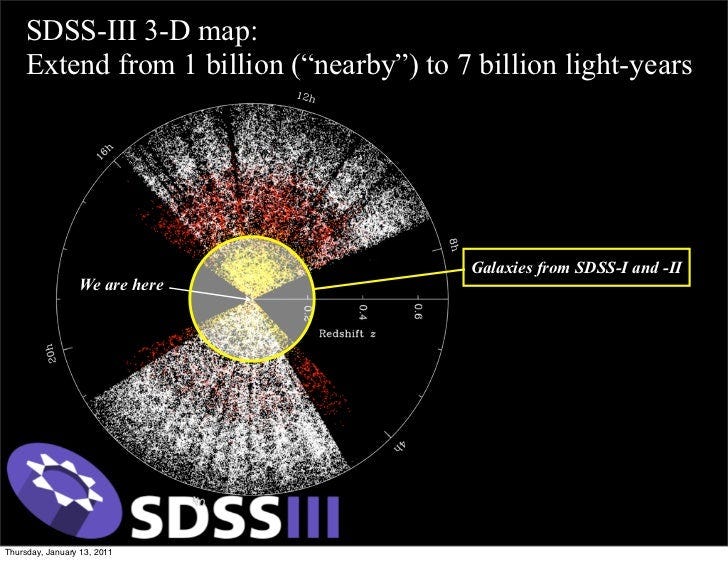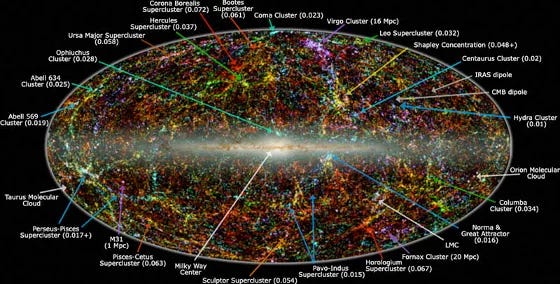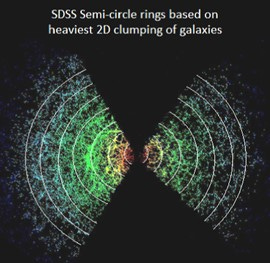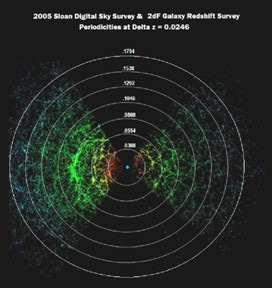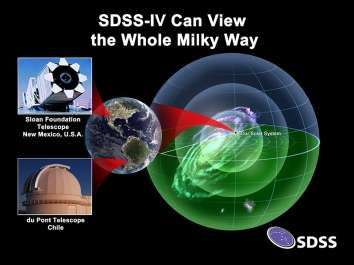Scientism and the Sloan Digital Sky Survey results. Mainstream cosmology in crisis.
Yet more proof that the Copernican Principle, the Big Bang, and even heliocentricity have little merit and even less observable evidence to support them.
Prologue
The Sloan Digital Sky Survey or SDSS, now more than 25 years old, was financed and created to provide the most accurate mapping of the galaxies, quasars, and other objects in the universe to date. It is a long-running project currently in phase 5. Hundreds of astronomers, dozens of institutions and observatories from around the globe are involved mapping out hundreds of thousands of galaxies, quasars, objects and of course the ever-elusive ‘dark matter’, without which, the entirely of the Big Bang theology fails. In their own words, the Sloan Sky survey:
…will map in detail one-quarter of the entire sky, determining the positions and absolute brightnesses of more than 100 million celestial objects. It will also measure the distances to more than a million galaxies and quasars… The SDSS addresses fascinating, fundamental questions about the universe…will tell us which theories are right – or whether we have to come up with entirely new ideas.
The Sloan Digital Sky Survey (SDSS) is a joint project of The University of Chicago, Fermilab, the Institute for Advanced Study, the Japan Participation Group, The Johns Hopkins University, the Los Alamos National Laboratory, the Max-Planck- Institute for Astronomy (MPIA), the Max-Planck-Institute for Astrophysics (MPA), New Mexico State University, University of Pittsburgh, Princeton University, the United States Naval Observatory, and the University of Washington. Funding for the project has been provided by the Alfred P. Sloan Foundation, the participating institutions, the National Aeronautics and Space Administration, the National Science Foundation, the U.S. Department of Energy, the Japanese Monbukagakusho, and the Max Planck Society.
A long list of the great and good institutions. The ‘establishment’ of academic cosmology no less. Yet as they declare in their mission statement, creating and developing new ideas will need to be undertaken, along with the decommissioning of the Big Bang religion and much of Copernicanism. The SDSS simply does not support either. Not that anyone is told this.
In fact, ‘The Science’ as it always has done when faced with evidence which eviscerates its dogma, will simply declare that the observations in fact support and confirm their theology! Indeed, it is ‘exactly as they expected’. We have heard the same for 200 years from the drugs-pharmaceutical industry, not to mention the non-sciences of evolution, medicine, virology, space exploration, and climate theology. In every sphere and cult within ‘The Science’ the above declarations are the standard mantra. Just ignore the evidence, obfuscate, issue propaganda, delete evidence and declare in ever-so confident tones that ‘The Science’ has been vindicated. After this confident assertion, supported by tortured data sets, collect your money.
It can’t be in the center!
By 2003, the SDSS had already discovered that the Earth seemed to be in the center of the known universe. Since then, the data has simply accumulated in support of this observation. However, howls of outrage and name-calling are sure to follow if this idea is either distributed or worse believed. But there it is.
The SDSS confirms that the Earth is in the center of two wedge-shaped galaxy segments near the ‘barycenter’ or center of universal mass. The SDSS also shows that galaxy density decreases as the distance from Earth increases, implying a concentric proportion leading to the Earth. This means that the Bangers cannot use the excuse that the view is from the observer, namely our Earth, and therefore ‘distorts’ the known universe’s map.
‘The Principle’ rubbished
If one were to perform a similar survey from another part of the universe, these concentric proportions would not appear. This means that the centrality of Earth provided by the Sloan Digital Survey is thus consistent with the quantization of redshift values that have been accumulated for five decades or more (Varshni, Alp). Once again, the ‘Copernican Principle’ is violated and no proof whatsoever can be offered in its defense. The ‘Copernican Principle’, is simply that the Earth is an unimportant little flattened spheroid at the centre of nothing and therefore by extension, humans are a blind chance artefact of no great import, probably evolved from panspermic space dust.
But the facts don’t support this misanthropy or its associated dogma. Concentricity and the heterogeneous distribution of galaxies are in defiance of mainstream cosmology’s claims and models including its vaunted ‘Copernican Principle’. The fact that the universe is not isotropic and does not show the same properties in every direction, as predicted by this ‘Principle’, means we have an anisotropic or heterogenous universe. Given these facts, if the observer view was to change from the Earth to somewhere else in the universe, we can see that the mathematical theorems underlying galaxy formation are wrong and this viewer would conclude that the Earth is at the center. Astronomer Harold Slusher wrote:
If the distribution of galaxies is homogeneous, then doubling the distance should increase the galaxy count eightfold; tripling it should produce a galaxy count 27 times as large. Actual counts of galaxies show a rate substantially less than this. If allowed to stand without correction, this feature of the galaxy counts implies a thinning out with distance in all directions, and that we are at the very center of the highest concentration of matter in the universe….This would argue that we are at the center of the universe.
When galaxy counts are adjusted for dimming effects, it appears that the number of galaxies per unit volume of space increases with distance. From this we still appear to be at the center of the universe, but now it coincides with the point of least concentration of matter (Slusher, pp. 12-13).
SDSS data, which again confirms anisotropy and heterogeneity, contradicts the Copernican Principle and what Bang theology predicts and demands.
Heliocentricity or Concentricity?
The image below, on the left, shows views of galaxies from a common center. The graph on the right shows a view of galaxies from two million light years from common center. This means that Earth’s distance from the common center is minimal. Concentric galaxies disappear unless observed from within 0.3% of the center of the universe.
As one scientist put it:
The probability P that we would be located in such a unique position in the cosmos by chance would be the ratio of the volumes involved, where R is the minimum radius of the cosmos estimated by observation, say about 20 billion light years. Using δr = 1.6 million light years gives a value for P less than 5.12 × 10-13. That is, the probability of our galaxy being so close to the centre of the cosmos by accident is less than one out of a trillion (Humphreys, August 2002)
In a 2010 paper by Hirano and Komiya, similar findings are offered:
A widespread idea in cosmology is that the universe is homogeneous and isotropic above a certain scale. This hypothesis, usually called the cosmological principle…is thought to be a generalization of the Copernican principle that “the Earth is not in a central, specially favored position.” The assumption is that any observer at any place at the same epoch would see essentially the same picture of the large scale distribution of galaxies in the universe.
…
A natural interpretation is that concentric spherical shells of higher galaxy number densities surround us, with their individual centers situated at our location…it has been demonstrated, from many numerical simulations using the Einstein–de Sitter and ΛCDM models, that the probability of getting such a periodic spatial structure from clustering and cosmic web filaments is less than 10−3 (Hirano and Komiya, p. 1).
10 to the negative 3 is .001 or 1 in 1000. The spatial data and observable evidence are that the Earth is near the barycenter of the Universe.
Arp the heretic
(Distribution of galaxies in space, Earth in the centre…)
It appears that Halton Arp is vindicated. Arp maintained that stars and their ‘redshift’ did not mean ‘long ages’, but in fact might mean the opposite. If ‘redshifting’ indicates a young age, the Universe would be much smaller than the Banging model maintains. Arp also supplied evidence that various galaxies and quasars occupy the same vicinity; the former producing the latter when material from the galaxy is ejected. If Arp is right, then obviously quasars are not at ‘cosmological’ distances from Earth, that is, they are not at the farthest reaches of the universe.
As Arp wrote:
“For supposed recession velocities of quasars, to measure equal steps in all directions in the sky means we are at the center of a series of explosions. This is an anti-Copernican embarrassment” (Arp, Seeing Red p. 195)
This observation was also confirmed by Varshni some 50 years ago (Varshni, pp. 3-8). He maintained that quantized redshifts must show irrefutable evidence of Earth’s centrality. SDSS data is confirming this prediction.
Arp and others also predicted that the higher redshift was for a quasar, the more newly formed it was from a much older galaxy. In addition, SDSS has proven Arp’s supposition that the galaxies were connected by an ‘umbilical cord of neutral hydrogen’ (Arp, p. 103). Arp’s key points (from another post) regarding ‘redshift’ include:
-Galaxies will form ‘quasars’ which are proto-galaxies, in a process of self-creation, this would entail that their ‘clocks’ are running slow and that their matter is redshifted
–Quasars are the most redshifted objects in the Universe, emitting photons with greater energy than the parent galaxy, and their redshift age given they are new, cannot be due to light recession related to cosmic expansion
-Observational data prove that quasars are younger matter, ejected from the nuclei of active galaxies, termed ‘White holes’
-Arp repeatedly discovered paired quasars on the edges of active galaxies
-Eventually the quasars form their own galaxies near to the parent galaxy and have been observed discharging their own quasar pairs
-This means that when we see light from distant galaxies it is much younger than we believe, the matter is new, not old, and that the distance-velocity relation means the Universe is probably not expanding
-The above eliminates the need for the mythical dark matter and dark energy
-For Arp, the CMB (cosmic background radiation, a supposed proof of the Big Bang rubbished here), is simply the temperature in space beyond our galactic neighbourhood
The SDSS has found that the redshifts of galaxy-pairs are quantized, that is, they appear in regular intervals and thus are not representative of a homogeneous universe. Both of these, the pairing and quantization, as predicted by Arp, would be impossible to explain from a Big Bang perspective (Hawkins, et al, p. L15). The data when objectively viewed across 46,400 SDSS quasars, is clear that Arp’s quantized quasar theory is valid (Bell & McDiarmid, p. 4.).
The Banging belief, first forwarded by Hubble in the 1930s who was motivated more by philosophy than data, that all quasars are speeding away from the Earth, as measured by their ‘redshift’ and the implied distance relation of radial velocity, is obviously wrong. But even if Hubble was correct, it would mean based on SDSS data, that the Earth is precisely in the center of this grand dispersion. Or, if we were to take the ‘other side’ and ‘prove’ that quasars are not speeding away at radial velocity, it would not matter. It would still mean that the Earth is in the center of the distribution of a much younger universe than previously calculated.
It does not matter how you view it; the answer is the same – the centrality of the Earth. This is the problematic charybdis and scylla for modern cosmology. The only real debate is about what it means for the Bangers and Relativists and how Copernicans will attempt to explain the purported age of this planet and the universe.
Copernicanism in trouble
The SDSS data has led to internecine warfare in the Copernican belief system between Big Bangers and the Steady Staters. Regardless of this emotional civil war, there is a larger problem for the entire corpus of Copernican belief. The accumulated data about galaxies and quasars obviously point to a non-Copernican periodicity which cannot be denied.
For neo-Tychonians or geo-centrists, the SDSS evidence allows them to claim evidence from both sides of the Copernican belief system. Neo-Tychonians believe that the planets in our solar system orbit the Sun, and that cluster revolves around the Earth, as does the Milky Way and universe at large. The Earth may or may not rotate (both can exist inside the Tychonian model).
Even if the Earth did orbit the Sun, the data is very suggestive that the Earth is at or near the barycenter of the universe. The evidence is becoming stronger that heliocentricity is at variance with reality with no mechanical proofs available that the Earth is mobile, and (literally) hundreds of thousands of experiments disputing such mobility (many posts here go through these). Universal geocentricity or geo-locus is what the data is stating.
Bottom Line
SDSS as a catalogue of galaxial and quasar data is without parallel in history. The Big Bang belief that ‘redshifting’ proves an infinite universe of some 14 billion years of age has been rubbished. Even worse for Copernicans, the data confirming redshift as an indication of a younger age rather than distance, completely eviscerates the need for a huge universe as well as long ages. In fact, it is possible given Arp’s calculations that we would have a universe only a little larger than Ptolemy’s, and certainly not large enough to accommodate 13.7 billion years of ‘evolution’. The whole edifice of modern Scientism would be evaporated.
The implications from the SDSS are enormous and they conform to an almost endless array of proofs calling into doubt ‘The Science’ of the Big Bang, the Special Theory of Relativity, Copernicanism, heliocentricity and diurnal rotation. It is not as if the SDSS mapping is unsupported by other data points and observations. Many posts here have outlined the absolute paucity of any real observational-mechanical evidence and experimentation to support heliocentricity, the Big Bang and long ages. Other posts have discussed redshifting and why Arp is probably correct.
In the end, whether redshift is cosmological or intrinsic, ‘The Science’ stands face to face with the potential reality of geocentrism. Entire world-views and theologies will need to be dismembered and new avenues of real science pursued. The shattering end of Thomas Kuhn’s ‘paradigms’ takes time, but the monumental import of what is occurring to destroy the commonly held narratives and associated religious belief systems is enormous. It is just a matter of time.
Sources
Harold S. Slusher, The Origin of the Universe: An Examination of the Big Bang and Steady State Cosmologies, El Cajon, CA, Institute for Creation Research, 1980
D. Russell Humphreys, “Our galaxy is the centre of the universe, ‘quantized’ redshifts show,”, Journal of Creation 16(2):95–104, August 2002
Koichi Hirano and Zen Komiya, “Observational Tests for Oscillating Expansion Rate of the Universe,”, October 28, 2010
E. Hawkins, S. J. Maddox and M. R. Merrifield, “No periodicities in 2dF Redshift Survey data,” Monthly Notices of the Royal Astronomical Society, Vol. 336, Is. 1, October 2002, p. L15
M. Bell & D. McDiarmid, “Six Peaks Visible in the Redshift Distribution of 46,400 SDSS Quasars Agree with the Preferred Redshifts Predicted by the Decreasing Intrinsic Redshift Model,” Submitted , March 7, 2006, p. 4.
Halton Arp, Seeing Red, Montreal, Apeiron, 1998,
Halton Arp, Seeing Red: Redshifts, Cosmology and Academic Science, 1997
Y. P. Varshni, "The Red Shift Hypothesis for Quasars Is the Earth the Center of the Universe" Astrophysics and Space Science, Vol. 43, No. 1, 1976, pp. 3-8






